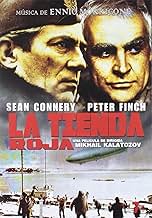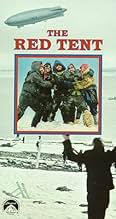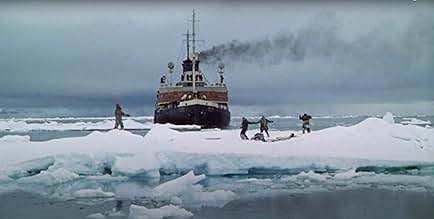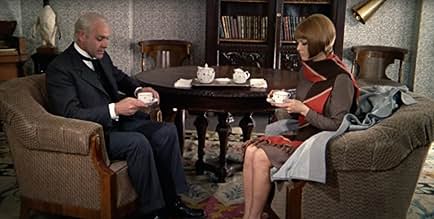Torn by personal guilt, Italian General Umberto Nobile reminisces about his failed 1928 Arctic expedition aboard the airship Italia.Torn by personal guilt, Italian General Umberto Nobile reminisces about his failed 1928 Arctic expedition aboard the airship Italia.Torn by personal guilt, Italian General Umberto Nobile reminisces about his failed 1928 Arctic expedition aboard the airship Italia.
- Awards
- 2 nominations total
- Einar Lundborg
- (as Hardy Kruger)
- Renato Alessandrini
- (uncredited)
Featured reviews
To date, the following films deal with this chapter of aviation history.
ZEPPELIN (Michael York has to stop the Kaiser's airforce from stealing the Magna Carta with their most modern designed Zeppelin.) THE COURT MARTIAL OF BILLY MITCHELL (Reference to the crash of the U.S. Navy Zeppelin Shenandoah in 1925, and the death of General Mitchell's (Gary Cooper's) friend, Captain Zachary Landsdowne. Mitchell was aware that the damaged Shenandoah was sent on a stupid political publicity tour in Ohio when it should have been repaired, and it was sent straight into a dangerous thunderstorm pattern.) THE RED TENT HINDENBERG (A film about the destruction of the great Zeppelin, with the emphasis on the theory that an anti-Nazi crewman put a time bomb on board. George C. Scott finds the bomb too late to stop the plot. It incorporates the footage of the Zeppelin's destruction).
THE RED TENT is an excellent film about the 1928 ITALIA disaster. I have referred to this in my review of the movie SCOTT OF THE ANTARCTIC. Briefly, General Umberto Nobile was an Italian aviation pilot and designer of "semi-rigids", a type of hybrid between a balloon and a zeppelin. A balloon has no shape, but is a bag full of heated air or hydrogen or helium, attached to a small carriage for the passengers (usually from two to five people. A zeppelin has a total framework and keel, which contains separate bags within, each containing hydrogen or helium gas lifting it. Unlike a balloon, which depends on the wind currents to steer the bag, the zeppelin has electric/gasoline motors that propel it in one direction or another. As zeppelins are large they require crews (usually of 24 or more men). The semi-rigid is a keel with half a framework, but the bags are not supporting a metal cover. Rather the bag is like an elongated balloon.
Nobile had great belief in his semi-rigids, but (like the zeppelins) they met with some success, some failure. In 1922 a semi-rigid he designed and sold to the U.S. Government, the ROMA, blew up in Hampton Roads, Virginia, when it touched a high tension wire that was across part of the field. It killed several dozen crewmen. On the other hand, in 1926 Nobile had designed a semi-rigid called the NORGE, which was used (successfully) for a flight over the North Pole.
THE RED TENT does not go into the details of this 1926 flight, which is a pity. If it did, it would explain some of the reasons for the immense public relations disaster the ITALIA proved to be.
To begin with, Nobile is an Italian. He was fully willing to work for the fascist government of Benito Musolini, but his work was only supported by that dictator as long as it's success was useful in advertising his regime's ability to make things better in Italy. However, one of the heroes of Fascist Italy, and one of the brightest men in the government, was the Italian war hero and aviation pioneer General Italo Balbo. Balbo is forgotten today, as he was tarred with being a supporter of the Fascists. What is forgotten is that in the 1920s up to 1935 fascism in Italy had many supporters, including Winston Churchill, who felt it was necessary to give Italy a strong centralized government. Balbo, within the Fascist regime, was a smart man who did his best to modernize the Italian air force and Italy's aviation industry. He also tried to emphasize Italy's ties to the democracies in the west - flying a flotilla of planes across the Atlantic in 1933 to the Chicago World's Fair on a good will tour. His attempts to keep friendly relations with the U.S., England, and France ran afoul of Il Duce, and may have led to the accident that ended Balbo's career (he was killed by "friendly fire" shooting down his plane over Libya in 1940).
Balbo was suspicious of the advantage of "lighter-than-air" aviation. He knew planes were getting larger and faster, and that the claims that long distance travel would only remain the province of zeppelins was a lot of hooey. So when Nobile presented him with his latest semi-rigids, Balbo questioned their real use. To be truthful (although Nobile did some fine work) history was on Balbo's side on this.
Nobile had to maintain his own friendship with Il Duce, and to do this, he needed successful results. Now the NORGE proved (as a machine) to be wonderful. It did fly to the North Pole. But the expedition was not so wonderful. The expedition was planned by the American explorer, Lincoln Ellsworth. He asked his friend, the great polar explorer Roald Amundsen to co-direct the expedition. And then they got Nobile to design the NORGE. The problem was that Nobile was insisting he was a co-leader with Ellsworth and Amundsen on the expedition. It is possible that if Ellsworth and Nobile had been alone there would have been no problem. The problem was Amundsen. He despised Musolini's regime, and considered Nobile nothing more than a talented mechanic and chauffeur. This was hardly fair, for it was an expedition to the Pole by air, and as such it would not have gotten anywhere without Nobile and his machine.
To make matters worse, while the NORGE was waiting in Spitsbergen for the right wind to travel to the Pole, a plane piloted by U.S. Navy Captain Richard Byrd and Floyd Bennett arrived. Byrd took off while the NORGE waited, and flew north. Within half a day it returned, and Byrd claimed he reached the Pole! Today we know from writings left by Bennett, and by some papers of Byrd showing his calculations, that he didn't reach the Pole, but in 1926 it was believed he did. This apparent success of heavier-than-air travel over lighter-than-air travel did not help endear Nobile's work with Amundsen.
So, despite the successful flight to the Pole and back (nobody seemed to notice that Byrd's American flag could not be found there), the NORGE voyage was not the great success Nobile needed. Balbo kept carping at the obvious comparison of the semi-rigid and Byrd's trimotor. And Il Duce was upset at the way that Nordic upstart Amundsen had slighted his representative. So Nobile decided he would design a larger semi-rigid and fly to the Pole leading this expedition by himself. Il Duce approved. Balbo just glared and said nothing.
THE RED TENT follows what happens. The voyage was a success again at the start. But an accident caused the ITALIA to crash on the ice, causing one of the gondolas to land on the ice with most of the crew. The out of control semi-rigid bounced back with nine men on board. It and the nine men drifted out of sight and were never seen again. Nobile (fortunately) had the main gondola, with the supplies and the radio. A red colored tent was set up on the ice, and distress signals were sent out. Certainly help would come.
But it didn't come. A very conservative and timid second in command had been left by Nobile in Spitsbergen, and although he got some of the signals he kept from releasing any requests for international assistance. After all, this fool reasoned, Nobile and the survivors should be rescued by Italians. Ordinarily this made sense, but Balbo and Musolini could not find the huge resources needed to assist in the rescue by themselves, particularly as the survivors were hundreds of miles north of Spitsbergen. So valuable time was lost.
Some of the survivors, the Finnish meteorologist Malmsen and two Italian crewmen, talked Nobile into letting them try to cross the ice to Scandanavia to get help. What happened next is not really known. In the film Malmsen dies of exhaustion and starvation but the Italians manage to survive. In reality the possibility exists that Malmsen was killed and eaten by the Italians (his body was never found).
Malmsen's girlfriend (Claudia Cardinale in the movie) goes to get Amundsen's assistance. In realty this was not necessary. Amundsen recalled Nobile with considerable distaste. As mentioned before he disliked the fascist regime, but there is a lingering feeling that he actually was a nordic racist who disliked Italians. He decided to get a plane and rescue Nobile (and proceed to humiliate the uppity "chauffeur" for his temerity at challenging Amundsen in polar ability). But the plane he got, a modern French plane, had an air cooled motor. Amundsen may have known much about planning depots of food, and knowing how much food to leave per member of an expedition, but he was not a mechanic (ironically enough). He and a small crew took off and were never seen again. Years later some wreckage was located, showing (according to Amundsen's fellow polar explorer, Vihiljamar Steffenson)that the plane must have crashed in the gulf stream, and that Amundsen and his crew died trying to use one of the wings as a raft.
A plane, piloted by an Italian, finally did arrive, but it only rescued Nobile. Nobile made the error of going first, presumably planning to return for the others. It turned out he did not have to - a Soviet ice breaker, the KRASSIN, arrived and rescued the remaining survivors (including the two Italians last seen with Malmsen).
Of course, Musolini was furious. There was a huge death toll. There was a humiliating example of possible cannibalism by two Italians. THere was a question of the cowardice of General Nobile in leaving his surviving crew behind. Finally the remaining men, all fascists mind you, were rescued by sailors from Communist Russia!
Balbo gleefully was able to convince his boss to shelve further "lighter-than-air" travel adventures (indeed further "lighter-than-air" transportation design). Nobile was openly disgraced by Il Duce, and left Italy (ironically he ended working for the Soviet Union, where Dirigibles were used for transportation for decades after the west stopped using them).
The movie is well acted by Peter Finch as Nobile, Sean Connery as Amundsen, and Cardinale as Malmsen's girlfriend. It glosses over the odd attitude of Amundsen towards Nobile, and the actual death of Malmsen. Amundsen, as one of the ghosts Finch talks to, says his plane crashed near the wrecked dirigible, and he was the last survivor of both groups. Supposedly, his final hours are spent reading Mark Twain's Huckleberry Finn. But the film does tackle the issue of command and leadership, and all the figures in the disaster are found to be lacking it. Nobile may not have been the coward Musolini claimed he was, but when asked by Amundsen what he thought of when he boarded the plane that took him away from the Red Tent, he realizes he did abdicate his responsibilities to his men: he only thought of taking a hot bath!
This is Director Mikheil Kalatozishvili's tribute to Sergei Eisenstein, a disorienting yet organized montage of vast scale juxtaposed with claustrophobic confinement (its worth watching again just to focus on the scene transitions-the editing is brilliant). The scenes inside the dirigible and the red tent (the title character) are carefully cut into spectacular exterior shots of arctic landscapes and the dynamic energy of crowds in the Russian countryside and city.
There is a fusion of European expressionism with Hollywood realism in this film unlike anything I have ever seen before. This is possible because of the storytelling device of having everything unfold in flashbacks by the main character General Nobile (Peter Finch). Nobile was the organizer and commander of Italy's ill-fated attempt to reach the North Pole by dirigible. This generally true (certain historical liberties are taken to simplify things) story is told entirely from his point of view.
Forty years after the expedition Nobile is a disgraced figure living in Rome and burdened by guilt and sleeplessness. You learn that on sleepless nights he conjures up participants in the expedition fiasco (both members and rescuers), letting them judge him for his actions 40 years ago. These sessions have been largely inconclusive but this night he pulls out all stops and convenes a full trial in his living room-with almost all the central figures present. More importantly, for the first time he names the ruthless Lundborg (Hardy Kruger) as his prosecutor-a move that Lundborg assures him will mean that the jury will reach a verdict for the first time. These are not ghosts but rather figments of Nobile's imagination and they behave according to his perception of how they would behave.
This storytelling device allows the film to have its own commentary, making it not just an exciting adventure film with wonderful visuals, but an examination of the concept of leadership (much like "Command Decision", "A Gathering of Eagles", and "They Came to Cordura"). More importantly it becomes an allegorical study about free will and destiny, as careful planning and good judgment are just two factors in any complex operation; subject to luck and unforeseen events.
The many characters are a representative cross section of society; with heroes, opportunists, martinets, dreamers, and average Joes. Ultimately, things happen (both good and bad) not because of the challenge of man versus nature, but because of the placement and misplacement of human resources (i.e. the right or wrong person assigned to a particular role in the expedition and the rescue efforts).
From the events portrayed in the "The Rent Tent" it is difficult to fault Nobile as a leader. He wisely turns back to Kings Bay when the weather gets bad, he is genuinely devastated at the loss of some of his men, and his actions after the crash are all reasonable. He can be blamed for allowing Lundborg to bring him out before his men but under the circumstances it was a sensible decision if not a politically correct one. As Samoilovich, Captain of the Russian Icebreaker Krassin points out, a leader is judged by their actions, and their actions by their results, Nobile's early rescue is the reason the other surviving crewmen are ultimately rescued.
Nobile's fantasy trial eventually dredges from his subconscious the realization of why he choose to leave with Lundborg (1000 reasons to stay-1001 to leave). That such a trivial and self-indulgent reason was the difference maker accounts for his continuing guilt. This realization, along with the belief that Amundsen (his peer) is the only one fit to judge him, allows Nobile to finally forgive himself for being human. They go out with Amundsen's advice to reflect not on their failures but on the things they attempted and the wondrous things they saw. There is no guilt in not achieving an ambitious goal, making the attempt is more important than succeeding.
The music is also great.
Then again, what do I know? I'm only a child.
That's a pity because photographically it's one of the finest things ever put on celluloid stock. There are some absolutely breathtaking shots of the frozen tundra and the performances of the actors battling the elements are first rate. Maybe a straight narrative might have been better instead of having the aged Nobile confronting some angry spirits of the past. Nobile was still alive when this film came out, he would die in 1978 still a figure of controversy. The dream with the angry spirits is a device frankly ripped off from George Bernard Shaw's St. Joan.
Maybe the film could be best compared to William Wellman's Island in the Sky that starred John Wayne. The fictional characters there are mostly rescued and held together by Duke's leadership. Of course some thirty years advance in aviation and no political interference helped Wayne's men. And Island in the Sky is a work of fiction.
Maybe it wouldn't be so if men of science could simply be men of science without answering to competing ideologies. Nobile and his men got caught up in the politics of the time. Politics claimed a lot of their lives and the lives of Roald Amundsen and party who vanished in a rescue attempt.
Nobile also made some bad choices and had some bad choices forced on him by Mussolini's fascist government. He was also a man out of his element, he was great aviation pioneer, but not a polar explorer. He paid with his reputation, some of his party paid with their lives.
Sean Connery has a small role as Roald Amundsen and I wish we had more of him here. Finch has a very effective scene with Claudia Cardinale the widow of one of his men where she takes him to task. Hardy Kruger does a fine job as the aviator presenting Finch with a very disagreeable choice.
I'd recommend seeing it, but only on the big screen. Or definitely in a letter box version. The formatted VHS I have definitely hampers the spectacle.
Highly imaginative, fictionalized version of these sad events . The film deal with General Nobile and Amundsen , but this is not a story of his race with Captain Scott to reach the South Pole -similarly to Cook and Peary in North Pole- , but a later episode in his moving career . Interesting and thought-provoking screenplay by prestigious writers : Richard DeLong Adams and Ennio De Concini though the script holds some inconsistencies in the dialogue . Big name cast who has to struggle hard to come to terms the strange happenings as when there appear ghost roles and all of them form a peculiar jury against General Nobile to be judged accused for desertion and cowardice . Very good acting by Peter Finch as Italian General Umberto Nobile torn by personal guilt . In between his last two assignment as James Bond , Connery gave some nice acting for the cinema and this portrait of the Norwegian explorer Amundsen is one of them . Sensitive and moving musical score by the great maestro Ennio Morricone . And colorful pictorial qualities of the cinematography are very strong . The yarn was compellingly directed by Mikhail Kalatozov (The cranes are flying , I Am Cuba) .
This roust man-versus-nature epic picture was well based on historical and biographic accounts , there are the followings : Umberto Nobile was an Italian aviator, aeronautical engineer and Arctic explorer. Nobile was a developer and promoter of semi-rigid airships during the period between the two World Wars . He is primarily remembered for designing and piloting the blimp Norge, which may have been the first aircraft to reach the North Pole, and which was indisputably the first to fly across the polar ice cap from Europe to America. Nobile also designed and flew the Italia, a second polar airship; this second expedition ended in a deadly crash and provoked an international rescue effort . The Italia, nearly identical to the Norge, was slowly completed and equipped for Polar flight during 1927–28. Part of the difficulty was in raising private funding to cover the costs of the expedition, which finally was financed by the city of Milan; the Italian government limited its direct participation to providing the airship and sending the aging steamer Città di Milano as a support vessel to Svalbard, under the command of Giuseppe Romagna . On 23 May 1928, after an outstanding 69-hour-long flight to the Siberian group of Arctic islands, the Italia commenced its flight to the North Pole with Nobile as both pilot and expedition leader. On 24 May, the ship reached the Pole and had already turned back toward Svalbard when it ran into a storm. On 25 May, the Italia crashed onto the pack ice less than 30 kilometres north of Nordaustlandet . Of the 16 men in the crew, ten were thrown onto the ice as the gondola was smashed; the remaining six crewmen were trapped in the buoyant superstructure as it ascended skyward due to loss of the gondola; the fate of the six men was never resolved. One of the ten men on the ice, Pomella, died from the impact; Nobile suffered a broken arm, broken leg, broken rib and head injury; Cecioni suffered two badly broken legs; Malmgren suffered a severe shoulder injury and suspected injury to a kidney; and Zappi had several broken ribs.The crew managed to salvage several items from the crashed airship gondola, including a radio transceiver, a tent which they later painted red for maximum visibility, and, critically, boxes of food and survival equipment which quick-witted engineer Ettore Arduino had managed to throw onto the ice before he and his five companions were carried off to their deaths by the wrecked but still airborne airship envelope and keel. As the days passed, the drifting sea ice took the survivors towards Foyn and Broch islands.A few days after the crash the Swedish meteorologist Finn Malmgren and Nobile's second and third in command Mariano and Zappi decided to leave the immobile group and march towards land. Malmgren, who was injured, weakened and reportedly still depressed over his meteorological advice that he felt contributed to the crash, asked his two Italian companions to continue without him. These two were picked up several weeks later by the Soviet icebreaker "Krasin". However, there were persistent rumors that Malmgren was killed and cannibalized .
Did you know
- TriviaSir Sean Connery, who received top billing, spent three weeks filming in Moscow. Peter Finch spent nine months on the production.
- GoofsDuring the final break up of the pack-ice, many shots are included that in fact depict the calving of icebergs at a glacier snout or edge of an ice-shelf. Pack-ice breaking up and icebergs calving are completely unlike each other visually - and, as physical phenomena, are entirely unrelated.
- Quotes
Aviator Lundborg: Men are risking their necks for fame, a medal, promotion, or money. What's wrong with money, mm? Just a means to happiness.
Roald Amundsen: But you don't look like a happy man, exactly. More like a man who's learned to be indifferent to unhappiness.
Aviator Lundborg: I'm glad you know it all, Mr. Amundsen.
Roald Amundsen: But you see, a man who is indifferent to his own unhappiness is indifferent to everything.
- Crazy creditsSome of the material for the Russian version listed the Scottish actor who plays Amundsen as "Sh. Konneri."
- Alternate versionsThe version released in the Soviet Union was significantly longer and featured an alternate score by composer Aleksandr Zatsepin instead of the score by Ennio Morricone used in the shorter European/American version.
- ConnectionsFeatured in Film o Mikhail Konstantinovich Kalatozov v Dvukh Chasmyakh (2006)
- How long is The Red Tent?Powered by Alexa
Details
Box office
- Budget
- $10,000,000 (estimated)
- Runtime2 hours 38 minutes
- Aspect ratio
- 2.20 : 1
Contribute to this page





































